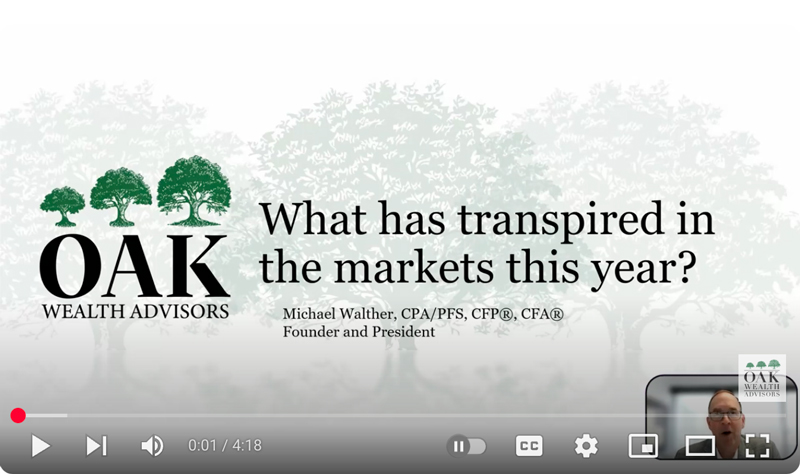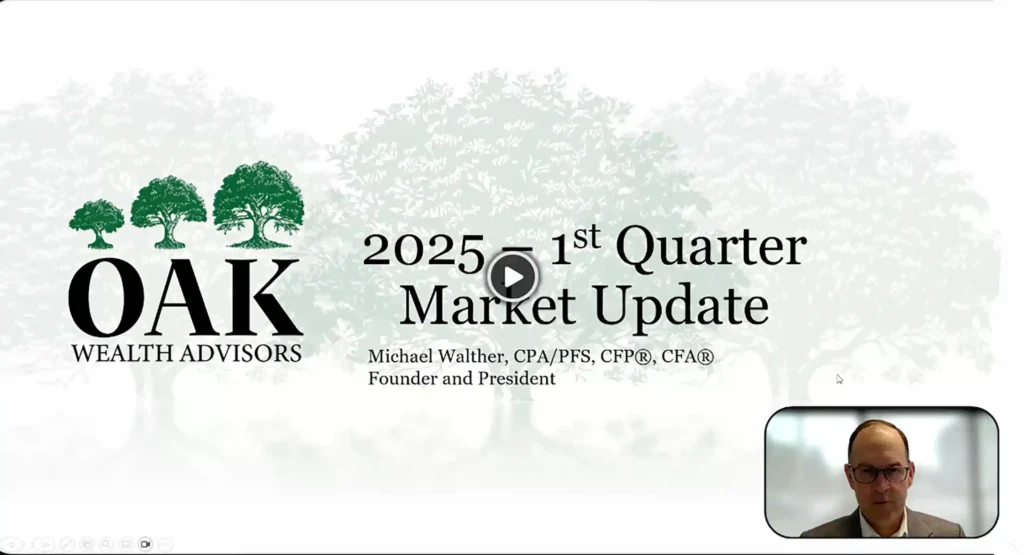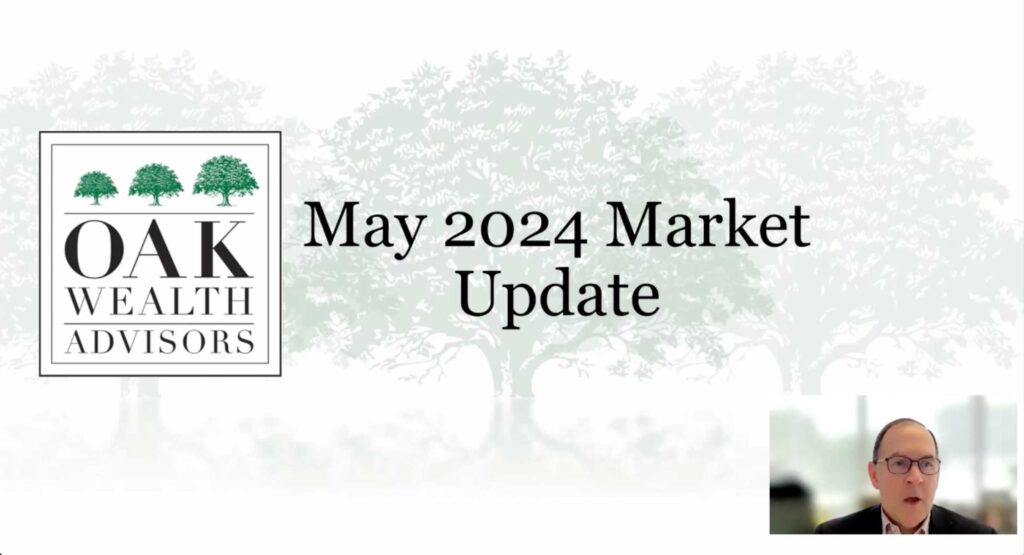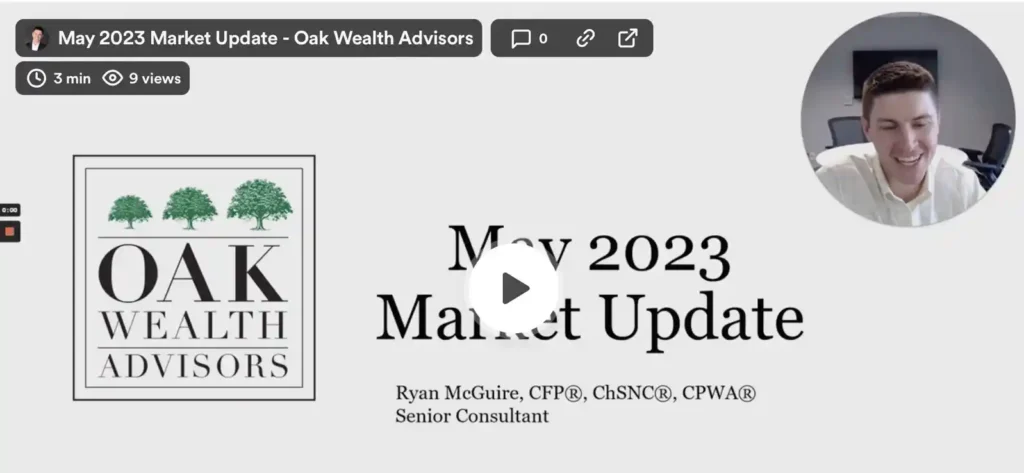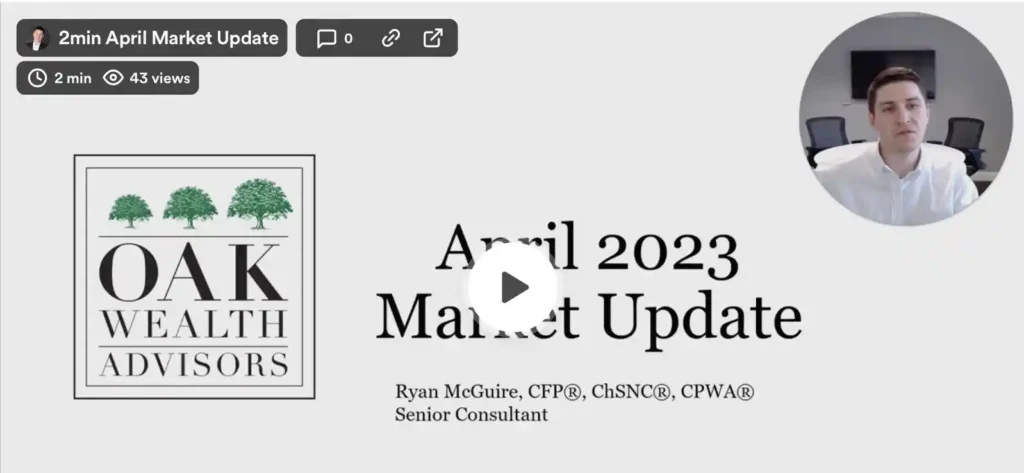PUBLISHED:
Hi, I’m Mike Walther from Oak Wealth Advisors with a different approach to planning.
I want everyone to think about what’s most important in their planning and whether or not the financial planning they’ve been doing actually addresses those things.
PUBLISHED:
Mike Walther, Founder and President of Oak Wealth Advisors with your June 2025 market update.
PUBLISHED:
We have new income tax planning software that we have been rolling out with clients in 2025. This software identifies income tax saving opportunities and provides tax planning recommendations. Please contact your advisor to evaluate your tax planning opportunities.
PUBLISHED:
Mike Walther, Founder and President of Oak Wealth Advisors with your 2025 first quarter market update.
PUBLISHED:
More good news to start 2025 for recent beneficiaries of inherited IRA accounts. If you inherited an IRA in 2020 or more recently from someone other than a spouse, you do not need to take one a required distribution in 2025. The IRS recently extended the time for taking required distributions until 2026 to allow for
PUBLISHED:
With 2025 on the horizon, Neil Mahoney discusses some end of the year planning items and important reminders heading into the new year.
PUBLISHED:
Below you will find a link to our 2025 Key Financial Numbers document. This document is meant to serve as a resource with a variety of financial numbers that are important for planning in 2025.
PUBLISHED:
Policy changes aren’t immediate after the election – With a new administration going into the White House next year, there are certainly going to be policy changes made, but how quickly does an agenda turn into laws and policies? Mike Walther shares why it might not be as immediate as many think.
PUBLISHED:
PUBLISHED:
May was a great month in the market, listen as Mike Walther breaks down some of the numbers and shares the returns that we have seen across the globe halfway through 2024.
PUBLISHED:
In our 1st Quarter Market Update, Mike Walther discusses the current state of the market and the returns we have seen to start 2024.
PUBLISHED:
IRA distribution rules have changed several times over the past several years so we want to make sure that you are familiar with the current rules for new IRA distributions…there are several different life expectancy tables that could apply depending on who are the beneficiaries of your IRA.
PUBLISHED:
Curious about the market impact of this year’s upcoming elections? Mike Walther breaks down the data findings and offers insights into what to expect as we head into 2024 in this video.
PUBLISHED:
Watch Video – Mike Walther of Oak Wealth Advisors explains – Predictions about future investment market performance often have more weight than they deserve, leading to financial hardships. Despite robust data, predicting market performance is nearly impossible. Learn more…
PUBLISHED:
Below you will find a link to our 2024 Key Financial Numbers document. This document is meant to serve as a resource with a variety of financial numbers that are…
PUBLISHED:
Mike Walther of Oak Wealth Advisors explains the important reasons on how and why to go about freezing your credit.
PUBLISHED:
First, I wanted to touch on recent market events. As many of you may have seen in the news and through accessing your investment accounts, the past few months have seen a nice run for equity and bond markets. Second, we wanted to ensure that our clients are aware of two federal programs that provide subsides for internet and phone service to Americans with permanent disabilities. These programs are known as the Lifeline program, and theAffordable Connectivity Program. Eligible households or individuals do have the ability to participate in both programs.
PUBLISHED:
In this video, I, Ryan McGuire, Senior Consultant at Oak Wealth Advisors, provide a recap of the market performance in September 2023. Despite the rough month, with declines in stocks, bonds, and complementary strategies, it’s important to stay focused on the long-term. Diversified portfolios are still in positive territory for the year, and the current high yields make investing in bonds attractive. While negative market volatility may persist, there are increasing opportunities in the future. Your continued confidence in Oak Wealth Advisors is appreciated, and feel free to reach out with any questions.
PUBLISHED:
In this video, I provide an update on planning opportunities created by the Secure Act that may be relevant to our clients. I discuss significant changes to the ages for required minimum distributions (RMDs) and catch-up retirement account contribution levels. I also highlight the ability to transfer leftover funds from a 529 College Savings account into a Roth IRA for a beneficiary, with important conditions to consider. Lastly, I touch on changes to inherited IRA required minimum distributions and how they impact families with children with special needs. Please watch the video for more details and action items.
PUBLISHED:
In this video, I, Ryan McGuire, Senior Consultant with Oak Wealth Advisors, provide an update on the market for August 2023. I discuss the market growth in July and the subsequent declines in August. Despite the declines, global stock markets have shown resilience throughout the year. I also highlight the importance of monitoring inflation and interest rates as they continue to be significant factors. I emphasize the need for a disciplined approach to investment and the potential risks of emotional decision-making during market volatility. Overall, I stress the importance of a long-term investment strategy for financial growth.
PUBLISHED:
In this video, I, Ryan McGuire, Senior Consultant for Oak Wealth Advisors, provide a comprehensive market update for June 2023. Despite concerns about a potential recession and uncertainty around the Federal Reserve’s strategy, stocks showed resilience in the second quarter. The S&P 500 Index rallied impressively, and both the pause in interest rate hikes and the June debt ceiling deal supported market performance. Small cap and mid cap stocks performed well, and international developed and emerging economies also saw positive returns. However, the Eurozone entered into a recession, and inflation rates remained high in Europe. Stay informed and make informed investment decisions based on the latest market trends.
PUBLISHED:
Aaron provides client service across all areas and strives to create impact-driven and meaningful relationships with families. Born and raised in Madison, WI, Aaron developed a close bond with his…
PUBLISHED:
May was somewhat of a disappointing month for most asset classes. The S&P 500 led the way, barely positive at 0.4%. Remaining stock asset classes fell around 1-4%. Bonds due to a small bounce back in interest rates fell around 1%. But when it comes to the U.S. Market rates, these numbers only tell a part of the story. Learn more in our May 2023 market update video…
PUBLISHED:
We hope you enjoy the first of what will become regular market updates from Oak Wealth Advisors. We intend to share market insights and our views about the investments we are making for you. Please share your feedback with us so that we can deliver information that you find helpful.
PUBLISHED:
Nobody has the ability to accurately forecast the future of investment markets, so we are not going to try with our 2023 market perspectives letter. Instead, we are going to highlight where the investment markets are relative to recent history and what those positions suggest about their relative attractiveness going forward.
As bad as 2022 was for both stocks and bonds — it was the worst year we have experienced for the combined categories in several decades —
Please click HERE if you’re having issues viewing this page.


